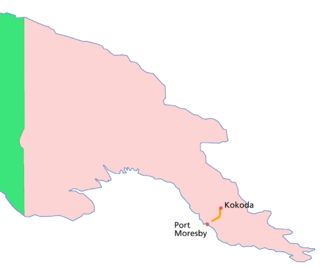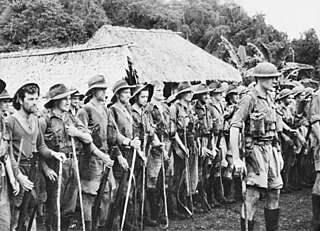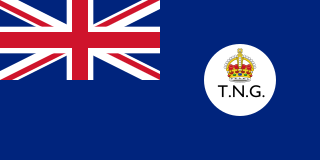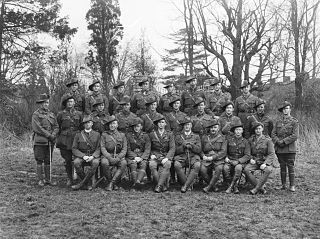Related Research Articles

The Kokoda Track or Trail is a single-file foot thoroughfare that runs 96 kilometres (60 mi) overland – 60 kilometres (37 mi) in a straight line – through the Owen Stanley Range in Papua New Guinea (PNG). The track was the location of the 1942 World War II battle between Japanese and Allied – primarily Australian – forces in what was then the Australian territory of Papua.
Maroubra Force was the name given to the ad hoc Australian infantry force that defended Port Moresby, Papua New Guinea from the Japanese, and was involved in the Kokoda Track Campaign of the Pacific War, World War II. The force was established by the Allies under the codename "Maroubra", referring to the troops in the forward area, it was one of many units forming the body of the New Guinea Force, the main Allied army formation in the South West Pacific Area during 1942.
Kokoda is a station town in the Oro Province of Papua New Guinea. It is famous as the northern end of the Kokoda Track, site of the eponymous Kokoda Track campaign of World War II. In that campaign, it had strategic significance because it had the only airfield along the Track. In the decades preceding, it had been a foothills settlement near the gold fields.

"Fuzzy Wuzzy Angels" was the name given by Australian soldiers to Papua New Guinean war carriers who, during World War II, were recruited or forced into service to bring supplies up to the front and carry injured Australian troops down the Kokoda trail during the Kokoda Campaign.

The Kokoda Track campaign or Kokoda Trail campaign was part of the Pacific War of World War II. The campaign consisted of a series of battles fought between July and November 1942 in what was then the Australian Territory of Papua. It was primarily a land battle, between the Japanese South Seas Detachment under Major General Tomitarō Horii and Australian and Papuan land forces under command of New Guinea Force. The Japanese objective was to seize Port Moresby by an overland advance from the north coast, following the Kokoda Track over the mountains of the Owen Stanley Range, as part of a strategy to isolate Australia from the United States.

The Territory of New Guinea was an Australian-administered League of Nations and then United Nations trust territory on the island of New Guinea from 1914 until 1975. In 1949, the Territory and the Territory of Papua were established in an administrative union by the name of the Territory of Papua and New Guinea. That administrative union was renamed as Papua New Guinea in 1971. Notwithstanding that it was part of an administrative union, the Territory of New Guinea at all times retained a distinct legal status and identity until the advent of the Independent State of Papua New Guinea.

The 39th Battalion was an infantry unit of the Australian Army. It was originally raised in February 1916 for service during World War I as part of First Australian Imperial Force, with personnel being drawn mainly from the state of Victoria. Making up part of the 10th Brigade, it was attached to the 3rd Division and served on the Western Front in France and Belgium before being disbanded in March 1919. Following the re-organisation of the Australian Army in 1921, the battalion was raised again in Victoria as a unit of the Citizens Force, becoming known as the "Hawthorn–Kew Regiment". In 1937, it was amalgamated with the 37th Battalion to become the 37th/39th Battalion. Later, in August 1939 it was delinked with the 37th and amalgamated with the 24th Battalion to form the 24th/39th Battalion, before being raised again as a single unit in October 1941.

Paul Ham is an Australian author who writes on the 20th-century history of war, politics and diplomacy. He lives in Sydney and Paris.

The invasion of Buna–Gona, called Operation RI by the Japanese, was a military operation by Imperial Japanese forces to occupy the Buna–Gona area in the Territory of Papua during the Pacific campaign of the Second World War. The initial landings and advance on Kokoda occurred between 21 and 27 July 1942. The Japanese invaded and occupied the location in preparation for an overland attack on Port Moresby along the Kokoda Track. The landing marked the start of the Kokoda Track campaign. The landings were not directly opposed by land forces but were engaged by elements of Maroubra Force as they advanced on Kokoda. This initially included B Company of the 39th Battalion, patrols of the Papuan Infantry Battalion (PIB) operating in the area and a small number of the Australian New Guinea Administrative Unit (ANGAU) that became attached to the force. The Australians were initially repulsed near Oivi but subsequently regrouped to defend Kokoda in an initial battle there from 28–29 July.
The Kokoda Challenge is a team endurance event, comprising an up-to 96km bushwalk, which takes place across Queensland, Australia throughout the year.
Captain Samuel Victor Templeton was an officer in the Australian Army during the Second World War. He is well known for his actions with the 39th Battalion as the commander of 'B' Company during the First Battle of Kokoda and went missing in action on 26 July 1942 near the village of Oivi.

The Battle of Isurava, also sometimes referred to as the Battle of Isurava – Abuari or the Battle of Isuraba, took place between 26 and 31 August 1942. Forming part of the Kokoda Track campaign of the Second World War, the battle involved military forces from Australia, supported by the United States, fighting against Japanese troops from Major General Tomitaro Horii's South Seas Detachment, who had landed around Buna and Gona in Papua mid-July 1942, with the intent of capturing Port Moresby to the south, via the overland route.

The battle of Buna–Gona was part of the New Guinea campaign in the Pacific theatre during World War II. It followed the conclusion of the Kokoda Track campaign and lasted from 16 November 1942 until 22 January 1943. The battle was fought by Australian and United States forces against the Japanese beachheads at Buna, Sanananda and Gona. From these, the Japanese had launched an overland attack on Port Moresby. In light of developments in the Solomon Islands campaign, Japanese forces approaching Port Moresby were ordered to withdraw to and secure these bases on the northern coast. Australian forces maintained contact as the Japanese conducted a well-ordered rearguard action. The Allied objective was to eject the Japanese forces from these positions and deny them their further use. The Japanese forces were skillful, well prepared and resolute in their defence. They had developed a strong network of well-concealed defences.

The Battle of Oivi–Gorari was the final major battle of the Kokoda Track campaign before the Battle of Buna–Gona. Following the capture of Kokoda by Australian forces on 2 November, the Allies began flying in fresh supplies of ammunition and food to ease the supply problems that had slowed their advance north after the climactic battle around Ioribaiwa, which coupled with reverses elsewhere, had stopped the Japanese advance on Port Moresby.

The Battle of Ioribaiwa took place between 14 and 16 September 1942, during the Kokoda Track campaign in Papua during the Second World War. Involving forces from Australia, the United States, and Japan, the fighting centred on a high feature known as Ioribaiwa Ridge, south of Ofi Creek on the Kokoda Track, in the Territory of Papua. It was the last of three defensive battles fought by the Australians along the Kokoda Track to halt the Japanese advance from the north coast of Papua towards Port Moresby.

The Battle of Kokoda consisted of two engagements fought in late July – early August 1942. Forming part of the Kokoda Track campaign of the Second World War, the battle involved military forces from Australia, supported by the United States, fighting against Japanese troops from Major General Tomitaro Horii's South Seas Detachment who had landed around Buna and Gona in Papua mid-July 1942, with the intent of capturing Port Moresby to the south via the overland route.

The First Battle of Eora Creek–Templeton's Crossing was fought from 31 August 1942 to 5 September 1942. Forming part of the Kokoda Track campaign of the Second World War, the battle involved military forces from Australia, supported by the United States, fighting against Japanese troops from Major General Tomitaro Horii's South Seas Detachment who had landed in Papua in mid-1942, with the intent of capturing Port Moresby. The battle was one of three defensive actions fought by the Australians along the Kokoda Track. The fighting resulted in the delay of the Japanese advance south, which allowed the Australians to withdraw to Efogi. Eora Creek village and Templeton's Crossing was subsequently the site of a battle in late October 1942 as the Australian forces pursued the Japanese forces retiring back toward the north coast of Papua.

The Second Battle of Eora Creek–Templeton's Crossing was fought from 11 to 28 October 1942. Forming part of the Kokoda Track campaign of the Second World War, the battle involved military forces from Australia, supported by the United States, fighting against Japanese troops from Major General Tomitaro Horii's South Seas Detachment who had landed in Papua in mid-1942, with the intent of capturing Port Moresby.

Templeton's Crossing is a locality on the Kokoda Track in New Guinea. The original track, at the start of the Kokoda Track campaign, proceeded north from Kagi and crossed over the watershed of the Owen Stanley Range as it passed through "the Gap" – skirting the eastern side of Mount Bellamy. The track then proceeded north through the steep-sided Eora Creek valley. Templeton's Crossing is where the original track first crosses Eora Creek. It was named by (then) Lieutenant Bert Kienzle in memory of Captain Sam Templeton. Templeton commanded B Company, 39th Battalion. It was the first of the battalion's companies to deploy overland for the defence of Kokoda – arriving shortly before the Japanese landings. Templeton was killed in the early stages of the Japanese advance. Kienzle was an officer of the Australian New Guinea Administrative Unit, that had been tasked, among other things, to establish supply dumps and staging points along the track. In the course of this, he was to guide Templeton's B Company over the track as it deployed.
Myola is a locality on the Kokoda Track in the Territory of Papua and the modern state of New Guinea. It is one of two closely located dry lake beds located near where the Kokoda Track crosses the crest of the Owen Stanley Range – also known as "the Gap" or "the Kokoda Gap". Myola, the smaller of the two lake beds, was located and named by Lieutenant Bert Kienzle on 3 August 1943. It became a major resupply point and drop zone for Australian forces during the Kokoda Track campaign. Kienzle then cut a track toward Eora Creek which rejoined the original track at Templeton's Crossing, which he also named.
References
- ↑ "Lost WWII battlefield found -– war dead included". Archived from the original on June 9, 2010.